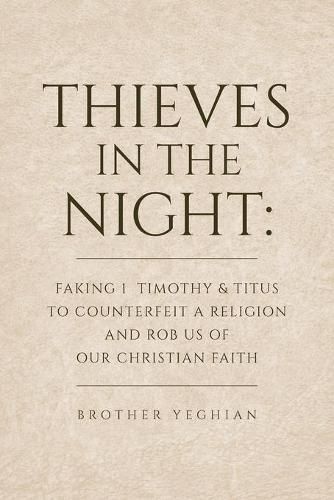Readings Newsletter
Become a Readings Member to make your shopping experience even easier.
Sign in or sign up for free!
You’re not far away from qualifying for FREE standard shipping within Australia
You’ve qualified for FREE standard shipping within Australia
The cart is loading…






This title is printed to order. This book may have been self-published. If so, we cannot guarantee the quality of the content. In the main most books will have gone through the editing process however some may not. We therefore suggest that you be aware of this before ordering this book. If in doubt check either the author or publisher’s details as we are unable to accept any returns unless they are faulty. Please contact us if you have any questions.
Brothers and sisters, once you know what you are looking at, it is so obvious a cave scholar could see it. 1 Timothy and Titus are phonier than a 3-dollar denarius.
Brother Yeghian has been studying the Greek New Testament from the oldest known Koine Greek manuscripts for over 45 years. With almost a half of a century of study behind him, and after struggling for seven years with how to communicate the nitty-gritty of some of the irregularities in 1 Timothy and Titus, along with how to explain the associated Greek grammar mumbo-jumbo, Yeghian offers this short book in an attempt to show some of these inconsistencies to absolutely any reader.
1 Timothy and Titus are the letters used in Paul’s name to found and organize churches. Yet, the strongest evidence that 1 Timothy and Titus were actually written by Paul is merely that the 4th century Byzantine Church founders said that they were. In order to make this short book available to anybody who wants to see some of these inconsistencies, the author sold his library to bring this to the public.
He confesses that he isn’t the greatest writer in the world, but to see these inconsistencies and thus why he would be motivated to sell off his books to get this in print, you will have to open this and read it for yourself. In addition to being used to keep women silent, the evidence presented here demonstrates that the letters that are primarily used to set up and run churches are fakes.
$9.00 standard shipping within Australia
FREE standard shipping within Australia for orders over $100.00
Express & International shipping calculated at checkout
This title is printed to order. This book may have been self-published. If so, we cannot guarantee the quality of the content. In the main most books will have gone through the editing process however some may not. We therefore suggest that you be aware of this before ordering this book. If in doubt check either the author or publisher’s details as we are unable to accept any returns unless they are faulty. Please contact us if you have any questions.
Brothers and sisters, once you know what you are looking at, it is so obvious a cave scholar could see it. 1 Timothy and Titus are phonier than a 3-dollar denarius.
Brother Yeghian has been studying the Greek New Testament from the oldest known Koine Greek manuscripts for over 45 years. With almost a half of a century of study behind him, and after struggling for seven years with how to communicate the nitty-gritty of some of the irregularities in 1 Timothy and Titus, along with how to explain the associated Greek grammar mumbo-jumbo, Yeghian offers this short book in an attempt to show some of these inconsistencies to absolutely any reader.
1 Timothy and Titus are the letters used in Paul’s name to found and organize churches. Yet, the strongest evidence that 1 Timothy and Titus were actually written by Paul is merely that the 4th century Byzantine Church founders said that they were. In order to make this short book available to anybody who wants to see some of these inconsistencies, the author sold his library to bring this to the public.
He confesses that he isn’t the greatest writer in the world, but to see these inconsistencies and thus why he would be motivated to sell off his books to get this in print, you will have to open this and read it for yourself. In addition to being used to keep women silent, the evidence presented here demonstrates that the letters that are primarily used to set up and run churches are fakes.